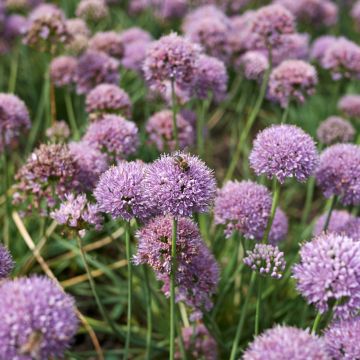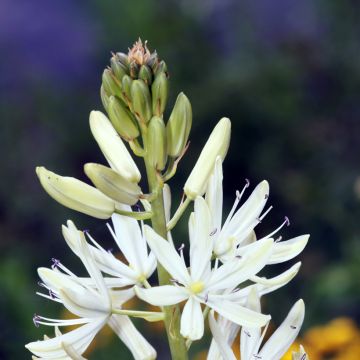

Allium nigrum Pink Jewel


Allium nigrum Pink Jewel


Allium nigrum Pink Jewel
Allium nigrum Pink Jewel
Allium nigrum Pink Jewel
Black Garlic, Broadleaf Garlic
Special offer!
Receive a €20 voucher for any order over €90 (excluding delivery costs, credit notes, and plastic-free options)!
1- Add your favorite plants to your cart.
2- Once you have reached €90, confirm your order (you can even choose the delivery date!).
3- As soon as your order is shipped, you will receive an email containing your voucher code, valid for 3 months (90 days).
Your voucher is unique and can only be used once, for any order with a minimum value of €20, excluding delivery costs.
Can be combined with other current offers, non-divisible and non-refundable.
Why not try an alternative variety in stock?
View all →This plant carries a 6 months recovery warranty
More information
We guarantee the quality of our plants for a full growing cycle, and will replace at our expense any plant that fails to recover under normal climatic and planting conditions.
Would this plant suit my garden?
Set up your Plantfit profile →
Description
Ornamental Garlic or Allium nigrum 'Pink Jewel' is a rather unique bulb as it is the only ornamental allium whose flower is truly pink. It unfolds in rounded umbels of star-shaped flowers with a well-marked green heart and pale green midribs on the reverse, carried by dark stems. This tall allium, whose flowering lasts a long time, enlivens the garden in June and July. It is hardy and blooms in full sun and in well-drained soils, rather dry in winter and summer.
Allium nigrum is native to Mediterranean regions, Western Asia, and North Africa. Very resistant to cold, it requires a very sunny exposure and soil that does not retain water. These plants belong to the Amaryllidaceae family. It is a herbaceous perennial plant with a bulb that can reach 5 cm in diameter. The foliage emerges in winter in warm climates, but appears later in cold and humid climates, usually in April. The 3 to 5 beautiful leaves of this ornamental allium are particularly wide and resemble those of leeks. They reach 2 to 3 cm in width and 50 to 60 cm in length: they are flat, linear, slightly curled at the edges, tapered at their ends, and light green. Initially erect, they bend over later. Unlike those of many species, the leaves of Allium nigrum do not have the characteristic onion, leek, or garlic smell of the genus. The floral stem, 60-70 cm tall, is leafless, thick, and sturdy.
'Pink Jewel' has the same height. From June-July (earlier in warm climates), pretty, 8-10 cm wide umbels, composed of about twenty 9 mm star-shaped flowers open, with pink petals traversed by a green midline, revealing a green heart. Their sweet and sugary fragrance as well as their richness in nectar attract pollinating insects. The seeds, which are produced in large quantities, easily self-sow in light soil. This Allium produces bulblets attached to the mother bulb. Caution: it is sensitive to rot in soil that is too wet in summer and/or waterlogged in winter.
Allium nigrum 'Pink Jewel' is charming in sunny borders, especially in a wild garden or in a naturalistic bed. It is light and elegant and pairs beautifully with small ornamental grasses like Stipa tenuifolia or Stipa barbata, as well as with thistles, Eryngiums or Echinops, cornflowers, Eremurus, or even ornamental carrots. Plant it in small groups of 3 to 5 bulbs among other plants, it will quickly multiply and form dense clumps that can be divided after 3 or 4 years.
Report an error about the product description
Allium nigrum Pink Jewel in pictures


Plant habit
Flowering
Foliage
Botanical data
Allium
nigrum
Pink Jewel
Amaryllidaceae
Black Garlic, Broadleaf Garlic
Allium multibulbosum, Allium dumetorum
Cultivar or hybrid
Other Allium
View all →Planting and care
Allium nigrum Pink Jewel should be planted at the beginning of autumn, at a depth of 8-10 cm, with each bulb spaced 15 cm apart. It is a winter-growing allium, which requires moist but well-drained soil in winter to start its growth period. However, the bulb likes to rest in rather dry soil in summer: this species is sensitive to rot in wet soil in summer. It tolerates poor soils well and accepts the presence of limestone. Choose a warm location and a very sunny exposure. Add sand and fine gravel to the planting to effectively drain the soil, heavy soils should be avoided to perpetuate this allium. Plant on a mound, in a rockery or in a raised bed if necessary (a 20 cm difference in elevation is sufficient). If the water does not stagnate, it can withstand harsh winters and slightly rainy summers.
Planting period
Intended location
Care
This item has not been reviewed yet - be the first to leave a review about it.
Similar products
Haven't found what you were looking for?
Hardiness is the lowest winter temperature a plant can endure without suffering serious damage or even dying. However, hardiness is affected by location (a sheltered area, such as a patio), protection (winter cover) and soil type (hardiness is improved by well-drained soil).

Photo Sharing Terms & Conditions
In order to encourage gardeners to interact and share their experiences, Promesse de fleurs offers various media enabling content to be uploaded onto its Site - in particular via the ‘Photo sharing’ module.
The User agrees to refrain from:
- Posting any content that is illegal, prejudicial, insulting, racist, inciteful to hatred, revisionist, contrary to public decency, that infringes on privacy or on the privacy rights of third parties, in particular the publicity rights of persons and goods, intellectual property rights, or the right to privacy.
- Submitting content on behalf of a third party;
- Impersonate the identity of a third party and/or publish any personal information about a third party;
In general, the User undertakes to refrain from any unethical behaviour.
All Content (in particular text, comments, files, images, photos, videos, creative works, etc.), which may be subject to property or intellectual property rights, image or other private rights, shall remain the property of the User, subject to the limited rights granted by the terms of the licence granted by Promesse de fleurs as stated below. Users are at liberty to publish or not to publish such Content on the Site, notably via the ‘Photo Sharing’ facility, and accept that this Content shall be made public and freely accessible, notably on the Internet.
Users further acknowledge, undertake to have ,and guarantee that they hold all necessary rights and permissions to publish such material on the Site, in particular with regard to the legislation in force pertaining to any privacy, property, intellectual property, image, or contractual rights, or rights of any other nature. By publishing such Content on the Site, Users acknowledge accepting full liability as publishers of the Content within the meaning of the law, and grant Promesse de fleurs, free of charge, an inclusive, worldwide licence for the said Content for the entire duration of its publication, including all reproduction, representation, up/downloading, displaying, performing, transmission, and storage rights.
Users also grant permission for their name to be linked to the Content and accept that this link may not always be made available.
By engaging in posting material, Users consent to their Content becoming automatically accessible on the Internet, in particular on other sites and/or blogs and/or web pages of the Promesse de fleurs site, including in particular social pages and the Promesse de fleurs catalogue.
Users may secure the removal of entrusted content free of charge by issuing a simple request via our contact form.
The flowering period indicated on our website applies to countries and regions located in USDA zone 8 (France, the United Kingdom, Ireland, the Netherlands, etc.)
It will vary according to where you live:
- In zones 9 to 10 (Italy, Spain, Greece, etc.), flowering will occur about 2 to 4 weeks earlier.
- In zones 6 to 7 (Germany, Poland, Slovenia, and lower mountainous regions), flowering will be delayed by 2 to 3 weeks.
- In zone 5 (Central Europe, Scandinavia), blooming will be delayed by 3 to 5 weeks.
In temperate climates, pruning of spring-flowering shrubs (forsythia, spireas, etc.) should be done just after flowering.
Pruning of summer-flowering shrubs (Indian Lilac, Perovskia, etc.) can be done in winter or spring.
In cold regions as well as with frost-sensitive plants, avoid pruning too early when severe frosts may still occur.
The planting period indicated on our website applies to countries and regions located in USDA zone 8 (France, United Kingdom, Ireland, Netherlands).
It will vary according to where you live:
- In Mediterranean zones (Marseille, Madrid, Milan, etc.), autumn and winter are the best planting periods.
- In continental zones (Strasbourg, Munich, Vienna, etc.), delay planting by 2 to 3 weeks in spring and bring it forward by 2 to 4 weeks in autumn.
- In mountainous regions (the Alps, Pyrenees, Carpathians, etc.), it is best to plant in late spring (May-June) or late summer (August-September).
The harvesting period indicated on our website applies to countries and regions in USDA zone 8 (France, England, Ireland, the Netherlands).
In colder areas (Scandinavia, Poland, Austria...) fruit and vegetable harvests are likely to be delayed by 3-4 weeks.
In warmer areas (Italy, Spain, Greece, etc.), harvesting will probably take place earlier, depending on weather conditions.
The sowing periods indicated on our website apply to countries and regions within USDA Zone 8 (France, UK, Ireland, Netherlands).
In colder areas (Scandinavia, Poland, Austria...), delay any outdoor sowing by 3-4 weeks, or sow under glass.
In warmer climes (Italy, Spain, Greece, etc.), bring outdoor sowing forward by a few weeks.

























































